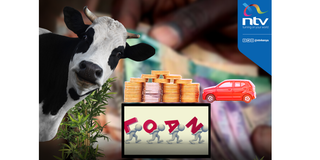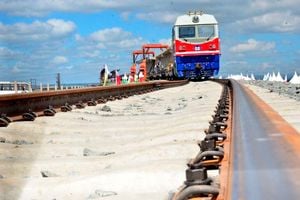Movable assets gain prominence as loan collateral on tough economy

The number of loans issued against movable assets such as household items, crops, livestock, and bank accounts increased by 15 per cent in the 12 months to June.
Motor vehicles, livestock, furniture, electronics and other movable property are gaining greater prominence in the growing search for loans by individuals and businesses amid an economic slowdown that has cut profits for firms and led to job cuts.
The increased demand for loans saw the Movable Property Security Rights (MPSR) registry record a 34 per cent increase in initial notices filed by financiers between July and December last year compared to the same period in the previous year.
Statistics from the Business Registration Service (BRS) show MPSR initial notices – which are registered by creditors to become a secured lender – rose sharply to 77,366 in the first half of the financial year 2022/23 compared to 57,748 notices in the same period of 2021/22.
Further, MPSR searches increased by 18.3 per cent to 12,798 from 10,811 in the previous year. The searches are made by lenders to ensure collateral has no encumbrances on it.
The sharp jump in notices signals that people are now increasingly utilising their movable property to secure loans, which has helped business owners unlock capital from otherwise idle assets that were previously not considered for use as collateral.
The increased use of the registry shows it is coming of age nearly five years after it was established to increase credit access to borrowers within the economy.
Movable property
Kenya enacted the Movable Property Security Rights Act in 2017, which provided a legal framework that governs the use of the movable property as collateral, which led to the establishment of the register in May 2017 to replace the chattels registry.
This has enabled borrowers to now use tangible movable assets such as motor vehicles, crops, machinery, livestock, business inventory, electronics and furniture, and intangible assets such as account receivables, account savings or deposits, unpaid invoices, electronic securities, shares and intellectual property as security for loans.
Demand for loans has grown sharply over the past year driven by the reopening of the economy as the spread of the Covid-19 pandemic started to dissipate allowing businesses to seek capital to revive their operations.
A recent survey by the Central Bank of Kenya (CBK) that polled banks and non-bank private sector firms shows businesses further expect demand for loans to increase in the short term.
“Fifty per cent of respondents expected private sector credit growth to be supported by expected increase in demand to meet business and personal needs,” said the survey.
“This as businesses initiate capital expenditures and the business environment continues to improve post-Covid-19 and post-elections, and optimism in the economic recovery and increased economic activity post-Covid-19 and post-elections, respectively.”
Further, 43 per cent of the respondents expected credit demand to increase in November and December last year as they sought to boost business finance and working capital requirements.
In addition, 33 per cent and 24 per cent of the respondents cited high inflation and increased demand for products as reasons for the expected demand for credit during the period.
Sh500 billion
This increased demand saw banks disburse an additional Sh500 billion to the private sector between October 2021 and October 2022, according to data from the Central Bank of Kenya (CBK).
It pushed private sector lending to Sh4.1 trillion in October from Sh3.6 trillion in the previous year on increased disbursements to agriculture, manufacturing, transport, real estate and consumer durables sectors.
High inflation continued to ravage the economy last year amid high costs of fuel and a weaker shilling souring the economic environment for businesses that were just recovering from the after-shocks of the pandemic.
Inflation rose to an average of 8.7 per cent in the quarter under review from 6.7 per cent in the corresponding quarter of 2021 mainly due to increased prices of food and non-alcoholic beverages, transport and energy.
Meanwhile, Kenya’s gross domestic product (GDP) grew by 4.7 per cent in the third quarter ended September from 9.3 per cent in a similar period, said the Kenya National Bureau of Statistics (KNBS).
During the quarter, the US dollar appreciated against Kenya shilling by 9.4 per cent from an average of 109.2 units in the third quarter of 2021 to 119.4 units in the same quarter of 2022.
“Most sectors posted decelerated growths owing to the significantly high growth rates recorded in the third quarter of 2021 that signified recovery from the impact of the Covid-19 pandemic,” said the Kenya National Bureau of Statistics.
In the quarter, Central Bank Rate (CBR) increased to 8.25 per cent in September 2022 compared to seven per cent during the same period in 2021. This applied upward pressure on interest rates as the average interest rates on loans and other advances issued by commercial banks increased to 12.41 per cent, up from 12.10 per cent in September 2021.
The use of MPSR has, however, not been without hitches.
Analysts from Kiragu Wathuta & Company Advocates noted that the National Transport and Safety Authority’s (NTSA) Tax Invoice Management system (TIMS) and the MPRS registry operate as two independent platforms despite both dealing with the registration of interests in motor vehicles.
The analysts said the fact that financiers can register security rights on both platforms means there is a duplication of that role, which may lead to conflict.
Motor vehicles
“In an ideal situation, there should be information exchanged between the two registries in regards to ownership and creation of securities over motor vehicles however that is not happening at present,” said the firm in a previous analysis.
“This presents an opportunity to clearly define the mandate of each registry so that the NTSA TIMS search reveals true ownership on the one hand and the MPSR search reveals any secured transactions with respect to the motor vehicle in question on the other.”





